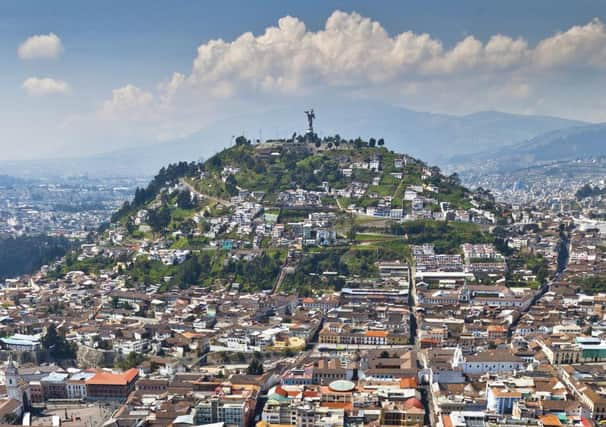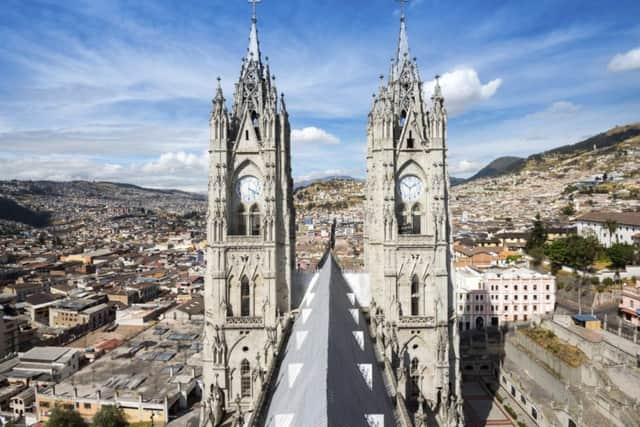Travel: The sky’s the limit in Quito, Ecuador
This article contains affiliate links. We may earn a small commission on items purchased through this article, but that does not affect our editorial judgement.


Despite the lure of the beaches of Rio de Janeiro, the Inca ruins of Machu Picchu and the tango flair of Buenos Aires, my inaugural trip to South America led me to Quito – capital of Ecuador and the world’s highest capital at 2,800 metres.
I didn’t really know what to expect, but flying into Quito, one thing became unmistakably clear. This was a big city – huge, in fact. Some 2.3 million people make Quito Ecuador’s second largest city after Guayaquil. From the plane I could see the city spilling into and over valleys and mountains (actually, volcanos as I later learned). The modern part of the city centre was clearly recognisable by its skyscrapers and office buildings, while numerous tall church spires pointed to the old part of town.
Advertisement
Hide AdI admit to having learned Spanish for two years at school, way back in the day, so when the taxi driver started a conversation like this: “Blablablabla…. Habla español?”, I half-heartedly answered “un poco”. The following waterfall of words rushed in and out of my ears, but when the driver looked at me expectedly, I could only ’fess up, replying: “No hablo español”.


He shrugged and drove me in silence for what felt like a very long hour into the city.
In the fading evening light, I could make out a large statue on a hill. Not daring to try my Spanish again, I tapped my driver on the shoulder and pointed to the structure. El Panecillo was going to be my first stop after a good night’s sleep, I decided.
In 1976, Spanish artist Agustín de la Herrán Matorras created a grand scale replica of the 18th century Virgin of Quito which still sits on the main altar of San Francisco Church.
The 45 metre statue is composed of almost 7,000 pieces, making it one of the largest aluminium structures in the world. “Virgen del panecillo” means “virgin of the little bread loaf,” named after the hill from which it dominates the city. Catholic this country may be, and with a sense of humour.
After a brisk 30 minute walk from the old part of town, including many steps climbing the “panecillo”, I opted to face some more within the structure. The inside houses a permanent exhibition about the construction of the virgin, while the outside platform delivers a stunning 360 degree view.
Advertisement
Hide AdIn the distance, I could see the snow-covered Cotopaxi volcano (5,897m) and the Basílica del Voto Nacional, my next stop. The first stone of this largest neo-Gothic basilica in the Americas was laid in 1892, but it was not until 1985 that the building was blessed by Pope John Paul II, and subsequently inaugurated in 1988.
The basilica, which measures 140m in the two frontal towers, is noted for its inclusion of Ecuadorian animals such as armadillos, iguanas and tortoises.
Advertisement
Hide AdAfter paying £2.50 I climbed various towers in the basilica, studied the church bells, and got a great close-up view of the colourful stained glass windows. This time, in reverse, I could see El Panecillo.
While walking through the narrow streets, past colourful façades and ostentatious churches, I understood why Quito was said to have the most beautiful Old Town in South America. It was impossible not to be charmed by these colonial remains which were designated a UNESCO World Heritage Site in 1978.
Quito’s central public square, Plaza de la Independencia, is flanked by the Carondelet Palace, the Metropolitan Cathedral, the Archbishop’s Palace, the Municipal Palace and the Plaza Grande Hotel. I sat on a shadowed bench, taking in the white stones, walls, arcades, pillars and balconies that seemed to sparkle in the bright sunlight. There were people everywhere, mostly locals such as shoe polishers, taxi drivers and street vendors trying to sell everything from fresh cherries to lottery tickets. “No, gracias” became my standard reply and the locals were friendly enough to leave it at that.
No visit to Quito Old Town is complete without entering at least one of the many historical churches, however it can prove difficult to get inside. I wandered past the famous La Iglesia de la Compañía de Jesús at least three times, always finding the surrounding fences locked, before getting lucky on the evening before my departure.
It is famous for its large nave, heavily decorated with gold leaf and wood carvings and it is unlike any other church I had ever been to.
The outside is also very unusual, and I learned that the carvings of the main façade were executed entirely of Ecuadorian andesite stone. Four different architectural styles (Baroque and Moorish, Churrigueresque and Neo-Classical) were merged in the construction of this building.
Advertisement
Hide AdOne thing I struggled with while in Quito was finding a good place to have dinner. Using the internet in my hunt for local food, I tried to track down various recommended restaurants only to be standing in front of locked doors at 7pm.
My aim to sample guinea pig, an Ecuadorian speciality, was unsuccessful, instead I ended up returning three times to the small but excellent Café Dios No Muere. Located in a 400-year-old building, the tiny restaurant was run by Mathieu Guillory, an expat from Louisiana, part-time coffee farmer and chef par excellence.
Advertisement
Hide Ad“I am a passionate admirer of the 19th century Ecuadorian president Gabriel Garcia Moreno, hence I named my café after his final words, ‘God Never Dies’,” Mathieu explained. Apart from listening to some great stories about life in Ecuador, the food was delicious and the hamburger with yucca fries for £2.50 was a bargain.
Quito’s officials are aware of the importance of the best-preserved, least altered historic centre in Latin America. The streets are cleaned regularly and at the weekends there’s a car-free pedestrian zone. I felt safe walking around anywhere in the Old Town and past sunset.
When my plane took off from Quito, I contemplated how much of Europe and its colonial history was still left in Quito and yet, how it had developed its very own identity. After all, I don’t know of any other place where a virgin statue is guarding a little loaf of bread…
• British Airways (www.britishairways.com), in partnership with Iberia, flies daily to Quito from London Heathrow via Madrid, from £695 including taxes.
The city has a wide range of accommodation. The family-run Hotel Boutique Portal de Cantuña (www.hotelportaldecantuna.com) has double rooms from £60 (breakfast included).